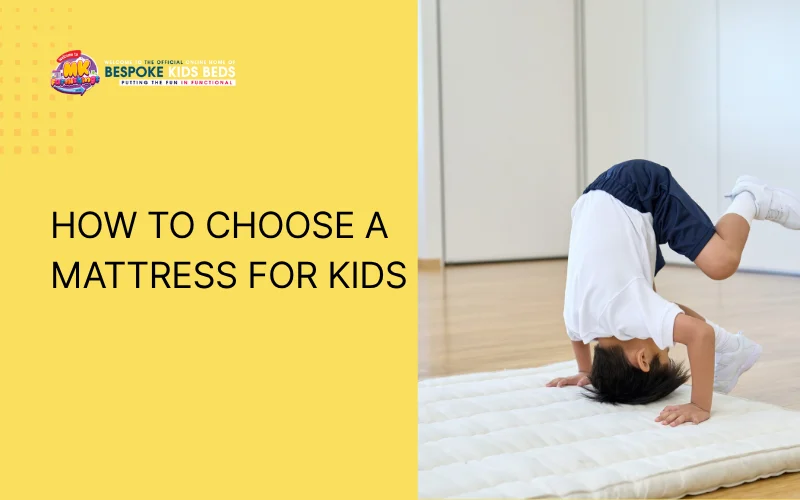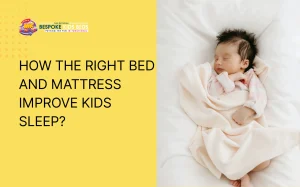
How High Is a High Sleeper Bed?
A high sleeper bed measures between 170 cm and 200 cm in total height, depending on the model and design. These beds create usable space
Enjoy FREE Delivery on All Orders!

The best way to choose a mattress for kids is to focus on safety, comfort, and suitability for their age and sleeping needs. A supportive mattress helps maintain proper spinal alignment, while comfort ensures children fall asleep easily and stay rested through the night. Parents should always look for safe, certified materials to avoid exposure to harmful chemicals, ensuring the mattress is non-toxic and child-friendly.
Beyond firmness and safety, practical factors matter just as much. A mattress for kids should be the correct size for both the child’s bed frame and bedroom space, and it should have breathable features to prevent overheating. Durability also plays a key role, as children’s mattresses face more wear and tear. Therefore, balancing quality with budget ensures lasting value.
The most important features to look for in a kids’ mattress are hypoallergenic design, cooling properties, waterproof protection, durability, and certified safety. These features not only improve comfort but also create a healthier sleep environment for kids. Parents should always check for trusted certifications to ensure the mattress is free from harmful substances. A well-chosen mattress supports growth and promotes restful sleep for kids.
A kids’ mattress should have hypoallergenic properties to protect against allergens that can disturb sleep and affect health. These features reduce the growth of dust mites, mould, and bacteria, which are common triggers for asthma and allergies. Natural materials such as organic cotton, latex, and bamboo are effective because they resist allergen buildup while staying breathable and gentle. A removable, washable cover further supports hygiene and makes maintenance easy. By choosing hypoallergenic mattresses, parents can create a cleaner and safer sleep environment that gives children consistent comfort, better health, and protection throughout their early years of development.
Children often sleep better on mattresses with cooling features that regulate body temperature. Overheating at night can cause restlessness, but cooling options such as gel-infused memory foam, breathable cotton, and moisture-wicking fabrics help maintain comfort for kids. Gel-infused foam disperses heat more effectively than standard foam, while open-cell structures promote airflow throughout the mattress. Breathable covers also add ventilation, preventing trapped heat. These features are especially valuable for children who naturally sleep hot or live in warmer conditions. A mattress designed with cooling materials helps maintain balanced sleep temperatures, ensuring kids wake up refreshed, energised, and ready for the day.
Children often spill food or drinks, and occasional night-time accidents are common, which makes waterproof or spill-resistant covers essential. These protective layers prevent liquids from seeping into the mattress core, safeguarding against mould, odours, and bacteria. Materials such as polyurethane-coated fabrics or vinyl-backed cotton are commonly used for kids because they combine effective waterproofing with comfort. For example, a mattress with a removable waterproof cotton cover is easy to clean while remaining soft and safe for children to sleep on. This feature ensures hygiene is maintained and improves child sleep hygiene by keeping the sleep surface fresh, clean, and safe after repeated use.
A mattress with breathable properties helps regulate temperature and keeps children comfortable during sleep. Materials like organic cotton, natural wool, and ventilated foams improve airflow, preventing heat buildup. Pocket-sprung mattresses with breathable padding also allow air circulation, lowering the risk of overheating. Good airflow reduces moisture accumulation, which can lead to bacteria or mould growth, and keeps the surface fresher for longer. Breathable fabrics enhance hygiene for kids while supporting cooler sleep conditions. A mattress that promotes airflow ensures uninterrupted rest, especially for active children who generate more body heat, leading to healthier and more restorative sleep every night.
Parents should always check for mattress certifications to confirm that products meet safety and quality standards. Certifications such as OEKO-TEX, GREENGUARD, and CertiPUR-US demonstrate that a mattress has been tested for harmful substances and low chemical emissions. For example, OEKO-TEX certification guarantees that fabrics are free from dangerous dyes and allergens, while GREENGUARD ensures low indoor emissions, reducing exposure to pollutants. CertiPUR-US certification applies to foams, confirming they are free from heavy metals, formaldehyde, and harmful flame retardants. These labels not only guarantee child safety but also reflect long-term durability and manufacturing quality. Choosing a certified mattress provides peace of mind, reassuring parents that the product is non-toxic, reliable, and safe for children’s everyday sleep.
The main factors to consider when choosing a mattress for kids are age, firmness, size, material, durability, and budget. These elements ensure the mattress matches your child’s growth stage and provides the right level of comfort and support. Parents should evaluate how each factor contributes to safe and restful sleep.
A child’s age directly influences the type of mattress they need, particularly in terms of firmness and dimensions. Infants and toddlers require firm mattresses that support spinal alignment and reduce risks associated with soft bedding. As children get older, medium firm mattresses provide a more comfortable balance between softness and support. Teenagers may benefit from mattresses that adapt to their changing body shapes and increased weight, such as hybrids or memory foam mattresses. Matching the mattress to the child’s age ensures consistent support and comfort while promoting healthy posture and safe sleep at every stage of development.
Firmness is one of the most important factors when choosing a mattress for children, as it affects both body support and spinal alignment. Babies and toddlers should always use firm mattresses to ensure safety and healthy development. Preschoolers and young children usually need medium firm options that balance structure with comfort. Older children and teens may benefit from adaptive surfaces that contour to the body, which raises a common question many parents have: Are memory foam mattresses good? When combined with proper firmness levels, a memory foam mattress can provide pressure relief without sacrificing stability for kids. Selecting firmness according to age and weight ensures comfort, safety, and healthy growth.
Mattress size for kids must always be chosen with safety and comfort in mind. A mattress should fit the bed frame securely, with no gaps that could create entrapment risks. The UK General Product Safety Regulations 2005 require that all consumer products, including children’s mattresses, are safe for use. According to the National Bed Federation, while there is no legally binding size tolerance in the UK, industry practice allows a variation of up to 20 millimetres from the advertised dimensions. For babies and toddlers, the mattress must fit snugly in a cot or small bed. Older children and teenagers need larger mattresses that provide space to grow while still fitting securely within the frame.
The type and quality of materials used in a mattress play a central role in comfort, support, and durability. Foam mattresses are affordable and lightweight, while pocket sprung models provide more structured support and airflow. Natural materials such as cotton, latex, and wool add breathability and hypoallergenic benefits. A mattress made from high-quality materials is more likely to remain supportive for years without sagging or losing shape. Parents should always review material composition carefully to ensure that the mattress supports long-term use and contributes to the child’s health and well-being.
Durability is essential because children often put more stress on mattresses through movement and play. In the UK, the Furniture and Furnishings (Fire Safety) Regulations 1988 require fillings and coverings to retain flame-retardant properties over time. Manufacturers may also use the BSI Kitemark as a certification of consistent quality and durability. Testing standards such as BS EN 1957 set guidelines for mattress resilience and performance after repeated use. A mattress that retains firmness, resists sagging, and performs well under strain provides better value for families. By choosing mattresses that meet or exceed these benchmarks, parents ensure reliable comfort and safety over many years.
Budget is a key factor in mattress choice for kids, but it should never come at the cost of safety or quality. Parents should aim to balance affordability with features such as firmness, durability, and material quality. In the UK, children’s mattresses typically start around £120 to £200 for basic foam or open coil models. Mid-range and premium mattresses, often with pocket springs, hybrid layers, or natural materials, usually cost between £200 and £400 or more. Checking warranty terms and trial options can help maximise value and reduce risk. By focusing on long-term durability and comfort, families can make a cost-effective choice that meets both budget needs and safety standards.
The best type of mattress for children depends on their age and stage of development. Babies and toddlers need firm, supportive options that prioritise safety, while children aged 4 to 7 benefit from medium firm mattresses with edge support. Teenagers often require larger hybrid or memory foam mattresses that adapt to their growing bodies. Choosing the right mattress for each age group helps maintain spinal alignment, improve comfort, and ensure long-term durability. Parents can use the following guide to select the most suitable mattress.
| Age Group | Recommended Firmness | Best Mattress Types | Key Features |
| Babies & Toddlers | Firm | Crib or cot mattress | Safety, hypoallergenic, breathable cover |
| Kids (4-7 years) | Medium firm | Pocket sprung or foam with edge support | Comfort, support, durability |
| Teens (8+ years) | Medium to medium soft | Hybrid or memory foam | Spinal support, adaptability, comfort |
The best mattress for babies and toddlers is firm and supportive, as safety is the primary concern at this stage. A firm surface reduces the risks of suffocation and helps maintain proper spinal alignment during early development. Parents should look for mattresses made with hypoallergenic materials, such as organic cotton or natural latex, to protect against allergies. Breathable fabrics are also essential, as they allow airflow and reduce the chance of overheating. Waterproof covers are highly recommended to protect against spills and accidents. To ensure safety, parents should check for certifications and confirm the mattress fits snugly in the cot or crib. By prioritising firmness, hypoallergenic design, and breathability, families can provide babies and toddlers with a mattress that is both safe and comfortable.
For children aged 4 to 7, the best mattress is medium firm with added edge support. At this age, children transition from toddler beds to bigger frames, so a mattress must balance comfort with durability. A medium firm feel ensures healthy spinal support while remaining soft enough for a restful night’s sleep. Edge support is particularly important, as it prevents sagging when children sit on the sides of the bed and maximises the usable sleep surface. Materials such as pocket springs combined with supportive foam layers provide stability and comfort. Parents should also ensure the mattress is durable enough to handle frequent movement and activity. By focusing on medium firmness, edge reinforcement, and comfort, families can choose a mattress that supports children during this important growth phase.
The best mattress for teenagers is often a hybrid or memory foam design that provides adaptable comfort and long-term support. Teenagers experience rapid growth and need mattresses that contour to their bodies while maintaining spinal alignment. Hybrid mattresses combine springs with foam layers, offering durability and responsiveness, while memory foam provides excellent pressure relief. A medium to medium soft feel is usually suitable, depending on the child’s weight and sleep preferences. Breathability is also important, as teens may generate more body heat. Larger sizes, such as single or small double, ensure enough room for comfort. Parents should invest in mattresses with good durability to last through the teenage years. A hybrid or memory foam option gives teens the support and comfort required for healthy sleep and development.
Choosing the right mattress for children requires balancing several factors, including age, firmness, size, material quality, durability, and budget. Each of these elements plays a role in ensuring children receive proper support, safety, and comfort throughout their development.
Parents should focus on firmness levels appropriate for their child’s age, hypoallergenic materials for health protection, and breathable designs to prevent overheating. Checking safety certifications provides added reassurance, while selecting a mattress size that matches both the bed frame and available space ensures practicality. Good mattress choices also promote child sleep hygiene, helping parents maintain a safe and clean environment.
With these factors in mind, parents can confidently navigate the mattress options available. By considering their child’s comfort preferences, health needs, and growth stage, they will be able to choose a mattress that promotes better sleep, safety, and well-being for years to come.
The best mattress for a 5-year-old is medium firm, as it provides the right balance of support and comfort during this growth stage. A medium firm surface maintains healthy spinal alignment while offering enough softness to promote restful sleep. Pocket-sprung mattresses or high-quality foam models are suitable, as they are durable and supportive. Parents should also ensure the mattress size matches the bed frame, such as a small single or standard single, depending on the room space. With these features, a 5-year-old enjoys safe, comfortable, and long-lasting sleep support.
A mattress is too firm for a child if it causes discomfort, poor sleep quality, or leaves pressure marks after rest. Children may complain of stiffness, or parents might notice frequent tossing and turning. The mattress should support the child’s spine without feeling rigid or unyielding. For example, if a medium firm option feels hard and prevents relaxation, it may not be suitable. Parents can test by lying on the mattress themselves; if it feels uncomfortably hard, it is likely too firm for a child’s needs.
Yes, memory foam can be a good option for kids’ mattresses, especially for older children and teenagers. Memory foam adapts to body shape, providing excellent pressure relief and comfort. However, it should not be used for babies or toddlers, as it can be too soft and pose safety concerns. Parents should choose high-quality, certified memory foam to ensure low emissions and safe materials. Combining memory foam with a supportive base, such as pocket springs, creates a balanced mattress that offers comfort, support, and durability for growing children.
The best mattress for toddlers with allergies is one made from hypoallergenic and non-toxic materials. Options such as organic cotton, natural latex, or bamboo fabrics reduce the risk of dust mites, mould, and bacteria, which are common allergy triggers. A washable, removable cover also helps maintain a hygienic surface. For example, a natural latex mattress with an organic cotton cover offers both support and allergy protection. Parents should always look for certifications like OEKO-TEX or GREENGUARD to confirm the mattress is safe and free from harmful chemicals.
Children’s mattresses should be replaced every 5 to 7 years, depending on wear and condition. Signs that a mattress needs replacing include sagging, lumps, loss of firmness, or complaints of discomfort from the child. Younger children may outgrow their mattresses sooner, especially when moving from a toddler bed to a larger frame.
Kyle Kane
Owner
Kyle Kane is Co-Owner of MK Furnishings, a family-run business based in UK that specializes in high-quality custom kids’ bunk beds, including triple, double, single, and themed designs. Since launching the company in 2016 alongside his brother-in-law, Kyle has helped deliver and assemble thousands of beds across the UK, Ireland, and beyond. Focused on customer satisfaction, Kyle leads a hardworking team that handles every step from ordering to delivery ensuring a smooth and professional service. His commitment to quality craftsmanship and reliable support has earned MK Furnishings a strong reputation and growing customer base throughout the region.

A high sleeper bed measures between 170 cm and 200 cm in total height, depending on the model and design. These beds create usable space

The right bed and mattress form the structural base to improve children’s sleep by providing proper spinal alignment and consistent support for their developing bodies.
Fancy £50 off all orders! Enter in 50off to redeem in the coupon code section